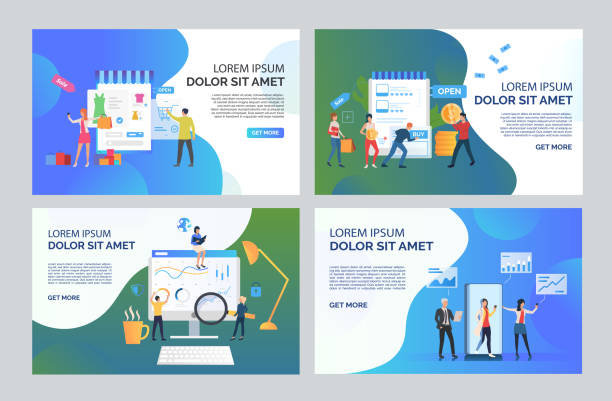Introduction to Responsive Web Design and its Importance

In today’s digital world, an online presence is essential for every business, and the quality of this presence is of high importance.
#Responsive_Web_Design is no longer a luxury option, but an undeniable necessity.
This design approach ensures that your website is displayed optimally on any device, from small smartphones to tablets, laptops, and large desktop monitors, providing a seamless user experience.
It is a fundamental concept in modern web development that goes beyond simply resizing elements, addressing how content is organized and presented across different screen dimensions.
Responsive web design is built upon the principles of flexibility and adaptability.
The main goal of this design is to improve the user experience.
Users expect websites to be easily viewable and usable without needing to zoom, scroll horizontally, or change device orientation.
If your website does not display correctly on a mobile device, users will quickly leave it and move to your competitors whose sites are responsive.
This issue not only harms your conversion rates and sales but also negatively impacts your brand’s reputation.
Therefore, investing in responsive web design is a strategic decision for your long-term online success.
In the rest of this article, we will delve deeper into various aspects of this important approach.
Did you know that poor online store design can drive away up to 70% of your potential customers? Rasaweb revolutionizes your sales with professional and user-friendly e-commerce website design.
✅ Significant increase in sales and revenue
✅ Full optimization for search engines and mobile
⚡ [Get Free Consultation from Rasaweb]
Why is Responsive Web Design Crucial for Your Online Success?

The importance of responsive web design is not limited to aesthetics; it is a key factor for success in the digital realm.
Given the significant increase in the use of mobile devices for internet access, having a website that works correctly on these devices is no longer a competitive advantage, but an industry standard.
Search engines like Google prioritize websites that provide a good user experience on mobile devices in their search rankings.
This means that a non-responsive site not only loses mobile users but also has less chance of being seen in organic search results.
In addition to SEO, this type of design directly impacts conversion rates and sales.
A website that is difficult to use on mobile drives users away and makes the purchase or registration process difficult for them.
In contrast, a responsive website creates a positive user experience by providing easy navigation, clickable buttons, and readable content on any screen size.
This positive experience leads to increased user dwell time on the site, reduced bounce rate, and ultimately increased conversion probability.
Furthermore, maintaining a responsive website is far simpler than managing separate desktop and mobile versions, which saves time and cost in development and maintenance.
This integrated platform facilitates content optimization and updates.
Fundamental Principles and Advanced Techniques in Responsive Web Design

Responsive web design is built upon three key principles: Fluid Grids, Flexible Images, and Media Queries.
Fluid grids use relative units like percentages for element widths instead of fixed pixels, allowing the website layout to adapt to the screen size.
Flexible images also adjust their size proportionally to their container using CSS, preventing overflow or excessive shrinking.
But the cornerstone of this approach is media queries, which allow developers to apply different CSS rules based on device characteristics such as screen width, height, orientation, and resolution.
These techniques, together, enable the creation of a seamless user experience.
Alongside these foundational principles, more advanced techniques are also employed in this type of design.
The Mobile-First approach, where design begins for the smallest screen and then scales up to larger devices, is one of the best practices to ensure excellent mobile performance.
The use of Flexbox and CSS Grid for designing more complex and dynamic layouts gives designers greater flexibility.
Additionally, image optimization (such as using next-gen formats, compression, and lazy loading) to improve loading speed, along with the use of scalable fonts and designing with touch targets in mind, are all important considerations in modern web design.
The table below shows some of the key components of this design.
| Component | Description | Importance |
|---|---|---|
| Media Queries | CSS rules for applying different styles based on device characteristics (e.g., screen width). | Adjusting layout and style for various screen sizes. |
| Fluid Grids | Using relative units (e.g., percentages) for element widths. | Layout flexibility across different dimensions. |
| Flexible Images | Automatic image size adjustment using CSS. | Preventing image display issues and improving performance. |
| Mobile-First Approach | Starting design from the smallest screen and scaling up. | Ensuring optimal performance and user experience on mobile. |
Benefits of Responsive Web Design for SEO and User Experience

One of the most important reasons businesses should move towards responsive web design is its significant impact on Search Engine Optimization (SEO).
Google has explicitly stated that it prioritizes mobile-friendly websites, and its algorithms are increasingly operating based on Mobile-First Indexing.
This means that if your site does not display correctly on mobile, its ranking in search results will drop.
A responsive site, with a single URL and a common codebase for all devices, prevents duplicate content issues and makes SEO management much simpler.
This uniformity helps search engines to crawl and index your content more easily.
In addition to SEO, this type of design significantly improves User Experience (UX).
Today’s users have high expectations, and if they cannot easily navigate your website or view content well, they quickly leave the site.
A responsive website, by providing an adaptable layout and intuitive navigation on any device, increases user satisfaction.
This leads to a reduced Bounce Rate, increased Dwell Time on the site, and ultimately increased engagement and conversion.
Improving UX not only boosts customer loyalty but also strengthens positive word-of-mouth, which is vital for your business growth.
This type of thoughtful UX design will increase your return on investment.
Did you know that poor online store design can drive away up to 70% of your potential customers? Rasaweb revolutionizes your sales with professional and user-friendly e-commerce website design.
✅ Significant increase in sales and revenue
✅ Full optimization for search engines and mobile
⚡ [Get Free Consultation from Rasaweb]
Common Challenges and Solutions in Implementing Responsive Web Design

Implementing responsive web design, despite its many advantages, is not without challenges.
One of the most common problems is managing complex and voluminous content.
How can a large amount of information be organized so that it is easily accessible and understandable even on a small mobile screen? The answer lies in smart content prioritization and hiding.
Using accordions, tabs, and dropdown menus can help organize content, while lazy loading images and videos improves loading speed.
Another challenge is ensuring consistent website performance across different browsers and various devices, which requires comprehensive and continuous testing.
Another issue often raised is Accessibility.
Is your responsive design also usable for users with special needs (such as visual or motor impairments)? Adhering to accessibility standards like WCAG, alongside responsive design, ensures that your site is usable for all users.
Other challenges include managing images with different resolutions and optimizing their loading, which can be solved using techniques such as srcset and the picture tag.
Also, ensuring that interactive elements like forms and buttons function correctly on all devices and are appropriately sized for touch is crucial.
This is an iterative process that requires continuous monitoring and improvement to achieve the best results.
Effective Tools and Frameworks in Responsive Web Design

To facilitate the responsive web design process, developers rely on a set of tools and frameworks.
Bootstrap and Foundation are two of the most popular CSS frameworks that provide a collection of ready-to-use components and a responsive grid system.
These frameworks help accelerate the development process and ensure that your website will be responsive from the outset.
Although their use can lead to additional code, they significantly increase the speed and ease of implementation.
The choice of the right framework depends on project needs and the development team’s preferences.
Alongside frameworks, Browser Developer Tools like Chrome DevTools play a vital role in debugging and testing responsive design.
These tools allow you to simulate your website in various screen sizes, inspect elements, and observe CSS changes live.
Additionally, tools like Google PageSpeed Insights and Lighthouse are essential for evaluating the performance and optimizing the speed of your responsive website.
Using CSS preprocessors like Sass or Less can also make the management of styles and media queries more organized and efficient.
By combining these tools and frameworks, the responsive design process becomes much simpler and more effective for designers and developers, allowing them to focus on creative and functional aspects.
Continuous Testing and Optimization in Responsive Web Design

After the initial implementation of responsive web design, the work is not over.
Continuous testing and optimization are crucial to ensure flawless website performance across all devices and browsers.
Testing stages include checking the layout, interactive element functionality, loading speed, and accessibility across various screen sizes.
Using device simulators in browsers, such as Chrome Developer Tools, is the first step.
These tools allow you to see how your site appears in different dimensions but cannot fully simulate the experience of using a real device.
For full assurance, testing on real devices and a range of popular browsers (such as Chrome, Firefox, Safari, Edge) is essential.
This helps you identify and resolve potential issues related to browser incompatibilities, touch functionality, or problems associated with specific resolutions.
In addition to manual testing, using automated testing tools like BrowserStack or CrossBrowserTesting can accelerate the process and ensure broader coverage of devices and browsers.
Optimizing loading speed by compressing images, using CDNs, and reducing HTTP requests also plays an important role in improving the user experience.
The table below summarizes key responsive testing tools and methods.
| Tool/Method | Description | Application |
|---|---|---|
| Browser Developer Tools | Ability to simulate different screen dimensions, inspect CSS and HTML. | Initial testing and debugging during development. |
| Testing on Real Devices | Using physical phones, tablets, and laptops. | Confirming real user experience and identifying device-specific issues. |
| Cross-Browser Testing Tools | Platforms like BrowserStack for automated and manual testing across various browsers and devices. | Ensuring compatibility across a wide range of environments. |
| PageSpeed Insights / Lighthouse | Google tools for website performance analysis and optimization suggestions. | Measuring and improving loading speed and UX. |
Future Trends in Responsive Web Design and the Role of AI

The future of web design, and consequently responsive web design, is evolving with the emergence of new technologies and increasing user expectations.
One of the most important future trends is a greater emphasis on performance and loading speed.
Users never wait for a site to load, and even milliseconds impact conversion rates.
Therefore, techniques such as Progressive Web Apps (PWAs), which bring native app functionalities to websites, and AMP (Accelerated Mobile Pages) for delivering super-fast content on mobile, will gain increasing importance.
These technologies also help improve user experience in poor network conditions.
Furthermore, the role of Artificial Intelligence (AI) in web design is becoming more prominent.
AI can assist in optimizing layouts, personalizing content based on user behavior, and even automating design processes.
For example, AI-powered design tools can automatically generate responsive layouts based on input content, or suggest performance optimizations.
Augmented Reality (AR) and Virtual Reality (VR) are also gradually entering the web space and will require novel approaches in responsive design to provide immersive user experiences across different platforms.
These changes promise an exciting future for responsive design, where websites will become not only more adaptable but also smarter and more interactive.
Did you know that poor online store design can drive away up to 70% of your potential customers? Rasaweb revolutionizes your sales with professional and user-friendly e-commerce website design.
✅ Significant increase in sales and revenue
✅ Full optimization for search engines and mobile
⚡ [Get Free Consultation from Rasaweb]
Case Studies and Best Practices in Responsive Design
![]()
To better understand the effectiveness of this type of design, examining successful examples and best practices can be very inspiring.
Large companies like Airbnb, Dropbox, and The Boston Globe have all designed their websites with a responsive approach and have reported positive results, including increased mobile traffic, improved conversion rates, and reduced maintenance costs.
For example, The Boston Globe website was a pioneer in this field, optimizing its content for readers on various devices using responsive design, and significantly increasing user satisfaction.
These examples demonstrate how a successful responsive strategy can contribute to business growth.
Best practices in this area include the “Mobile-First” approach, where design starts from the smallest screen to ensure that the core experience is fully optimized for mobile devices.
Additionally, using scalable web fonts, optimizing images for different sizes (using `srcset` or `
Paying attention to easy navigation and designing buttons and interactive elements with sufficient size for finger touch (large touch targets) is also very important for improving the mobile user experience.
Adhering to these tips and learning from the successful experiences of others can help you in creating an efficient and effective responsive website.
Conclusion and Next Steps for Responsive Web Design

In this article, we thoroughly discussed the importance, principles, challenges, and future trends of responsive web design.
It is clear that in the current era, having a responsive website is not just an advantage, but a vital requirement for any business that wants to be competitive in the online space and provide an optimal user experience for its audience.
From improving SEO and search engine rankings to increasing conversion rates and customer satisfaction, the benefits of this web design approach are undeniable.
The future of the web is also moving towards smarter and more adaptable platforms, and responsive design is at the heart of this transformation.
For the next steps, if your website is not yet responsive, it’s time to prioritize this change.
Starting with a comprehensive redesign or at least gradually optimizing key elements can have a profound impact on your online presence.
Furthermore, for businesses that already have a responsive website, focusing on continuous performance optimization, loading speed, and implementing advanced features like PWA can keep them at the forefront of the competition.
By investing in responsive web design, you are not only investing in the future of your business but also demonstrating your commitment to providing the best possible experience to users.
Frequently Asked Questions
| Question | Answer |
|---|---|
| What is Responsive Web Design? | It is a method for designing and implementing websites that causes the layout and content of the page to automatically adjust and display optimally based on the screen size of the user’s device (desktop, tablet, mobile, etc.). |
| Why is responsive design important? | With the increased use of various devices to access the web, a responsive site improves user experience, reduces bounce rate, strengthens site SEO, and makes site management and maintenance easier (instead of having separate versions for mobile and desktop). |
| How does responsive design work? | This type of design uses techniques such as flexible grids and layouts (Flexbox, CSS Grid), flexible images and media, and most importantly, CSS Media Queries, to change page styles and layouts based on screen characteristics (width, height, resolution, etc.). |
| What are the main tools for implementing responsive design? | The main tools include HTML5 (for content structure), CSS3 (especially Media Queries, Flexbox, Grid for responsive styling and layout), and sometimes JavaScript for more complex interactions. |
| What are the main benefits of using responsive design? | The main benefits include increased user accessibility (covering a wide range of devices), improved user experience, improved site ranking in search engines (especially Google), reduced development and maintenance costs, and increased visitor-to-customer conversion rates. |
And other advertising services from Rasaweb Advertising Agency:
Smart UI/UX: Revolutionize sales by optimizing key pages.
Smart Website Development: Professional solution for online growth focusing on SEO-driven content strategy.
Smart Data Analysis: Designed for businesses seeking to analyze customer behavior through Google Ads management.
Smart Social Media: Professional solution for analyzing customer behavior with a focus on smart data analysis.
Smart UI/UX: Professional optimization for digital branding using key page optimization.
And over a hundred other services in internet advertising, advertising consultation, and organizational solutions.
Internet Advertising | Advertising Strategy | Advertorials
Resources
Responsive Design Tutorial
Modern Business Websites
Importance of Responsiveness in SEO
Principles of Responsive Website Design
? Rasaweb Afarin, your strategic partner in the digital world, brings your business to the peak of success by providing innovative marketing solutions and professional e-commerce website design. For a free consultation and to learn more about our services, contact us now. The bright future of your business begins with Rasaweb Afarin.
📍 Tehran, Mirdamad Street, next to Bank Markazi, Southern Kazeroon Alley, Ramin Alley, No. 6

